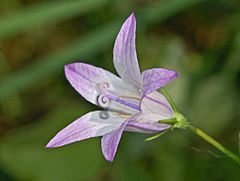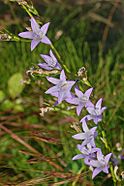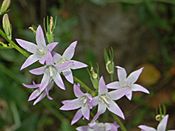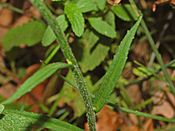Campanula rapunculus facts for kids
Quick facts for kids Campanula rapunculus |
|
|---|---|
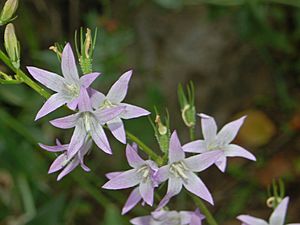 |
|
| Scientific classification | |
| Genus: |
Campanula
|
| Species: |
rapunculus
|
Campanula rapunculus, common name rampion bellflower, rampion, rover bellflower, or rapunzel, is a species of bellflower (Campanula) in the family Campanulaceae.
This species was once widely grown in Europe for its leaves, which were used like spinach, and its parsnip-like root, which was used like a radish. The Brothers Grimm's tale Rapunzel took its name from this plant.
Etymology
The genus Latin name ("campanula"), meaning small bell, refers to the bell-shape of the flower, while the specific name ("rapunculus") is a diminutive of the Latin "rapa" (turnip) and means 'little turnip', which refers to the shape of the root.
Description
This biennial herbaceous plant reaches on average 40–80 centimetres (16–31 in) of height, with a maximum of 100 centimetres (39 in) . The stem is erect, lightly hairy, branched on the top. The basal leaves are petiolated, ovate, slightly toothed and arranged in a rosette, while the upper leaves are sessile and narrow lanceolate. The hermaphrodite flowers are clustered in a racemose inflorescence, with a bell-shaped, light blue or violet corolla, about two centimeters long. They are arranged along the stem in a fairly narrow one-sided facing cluster. The flowering period extends from May through September. The fruit is a dehiscent capsule in the form of inverted cone with many seeds. The thick root looks like a small turnip and it is edible.
Distribution
Campanula rapunculus is present in western Asia, northern Africa and in most of Europe, except Iceland, Ireland and Norway. It has been introduced in Denmark, southern Sweden and Great Britain. This species was once widely grown in Europe for its leaves, which were used like spinach, and its parsnip-like root, which was used like a radish.
Habitat
This species prefers limestone soils and grows in dry meadows, cultivated beds, forests of oaks and pine trees, along roadsides and lane, at an altitude of 0–1,500 metres (0–4,921 ft) above sea level.
Synonyms
- Campanula elatior Hoffmanns. & Link
- Campanula lusitanica f. bracteosa (Willk.) Cout.
- Campanula lusitanica f. racemoso-paniculata (Willk.) Cout.
- Campanula lusitanica f. verruculosa (Hoffmanns. & Link) Cout.
- Campanula lusitanica var. cymoso-spicata (Willk.) Cout.
- Campanula lusitanica auct.
- Campanula verruculosa Hoffmanns. & Link
Gallery
See also
 In Spanish: Rapónchigo para niños
In Spanish: Rapónchigo para niños


